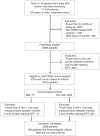Accuracy of WHO CD4 cell count criteria for virological failure of antiretroviral therapy
- PMID: 19624478
- PMCID: PMC3722497
- DOI: 10.1111/j.1365-3156.2009.02338.x
Accuracy of WHO CD4 cell count criteria for virological failure of antiretroviral therapy
Abstract
Objectives: To examine the accuracy of the World Health Organization immunological criteria for virological failure of antiretroviral treatment.
Methods: Analysis of 10 treatment programmes in Africa and South America that monitor both CD4 cell counts and HIV-1 viral load. Adult patients with at least two CD4 counts and viral load measurements between month 6 and 18 after starting a non-nucleoside reverse transcriptase inhibitor-based regimen were included. WHO immunological criteria include CD4 counts persistently <100 cells/microl, a fall below the baseline CD4 count, or a fall of >50% from the peak value. Virological failure was defined as two measurements > or =10 0000 copies/ml (higher threshold) or > or =500 copies/ml (lower threshold). Measures of accuracy with exact binomial 95% confidence intervals (CI) were calculated.
Results: A total of 2009 patients were included. During 1856 person-years of follow up 63 patients met the immunological criteria and 35 patients (higher threshold) and 95 patients (lower threshold) met the virological criteria. Sensitivity [95% confidence interval (CI)] was 17.1% (6.6-33.6%) for the higher and 12.6% (6.7-21.0%) for the lower threshold. Corresponding results for specificity were 97.1% (96.3-97.8%) and 97.3% (96.5-98.0%), for positive predictive value 9.5% (3.6-19.6%) and 19.0% (10.2-30.9%) and for negative predictive value 98.5% (97.9-99.0%) and 95.7% (94.7-96.6%).
Conclusions: The positive predictive value of the WHO immunological criteria for virological failure of antiretroviral treatment in resource-limited settings is poor, but the negative predictive value is high. Immunological criteria are more appropriate for ruling out than for ruling in virological failure in resource-limited settings.
Comment in
-
"Absolute" or "added" predictive value?Trop Med Int Health. 2010 Mar;15(3):382; author reply 382-4. doi: 10.1111/j.1365-3156.2009.02465.x. Epub 2010 Jan 14. Trop Med Int Health. 2010. PMID: 20074084 No abstract available.
References
-
- Bisson GP, Gross R, Strom JB, et al. Diagnostic accuracy of CD4 cell count increase for virologic response after initiating highly active antiretroviral therapy. AIDS. 2006;20:1613–1619. - PubMed
-
- Braitstein P, Brinkhof MW, Dabis F, et al. Mortality of HIV-1-infected patients in the first year of antiretroviral therapy: comparison between low-income and high-income countries. Lancet. 2006;367:817–824. - PubMed
-
- Calmy A, Ford N, Hirschel B, et al. HIV viral load monitoring in resource-limited regions: optional or necessary? Clinical Infectious Diseases. 2007;44:128–134. - PubMed
Publication types
MeSH terms
Substances
Grants and funding
LinkOut - more resources
Full Text Sources
Medical
Research Materials
Miscellaneous


